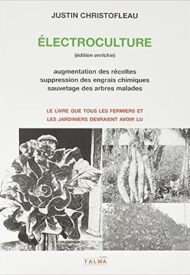Welcome to Electroculture Magazine, your go-to source for electrifying insights in the realm of agriculture! In this thought-provoking blog post, we dive deep into the controversial topic of “Electroculture Debunked, True or False?” Get ready for a journey of exploration and critical analysis as we separate fact from fiction. We delve into the claims and counterclaims surrounding electroculture, examining the scientific evidence and addressing common misconceptions.
Join us as we navigate through the realm of skeptics and proponents, unraveling the truth behind this revolutionary farming technique. Through rigorous research and expert perspectives, we aim to provide you with an unbiased examination of electroculture, allowing you to form your own informed opinion. Prepare to challenge your preconceived notions and engage in an enlightening discussion about the potential and limitations of electroculture. Let’s unravel the truth together and shed light on the electrifying world of agriculture.
The concept of electroculture, which combines science and nature, has been the subject of much debate and conjecture. From enhanced plant growth to increased crop yields, the potential benefits are astounding. But is everything a myth? Or does electroculture contain the key to a future that is greener and more sustainable?
Introduction: Electroculture Debunked
In the dynamic realm of agriculture, the concept of electroculture has ignited fervent discussions and fueled hopes for transformative advancements. This innovative technique involves utilizing electrical energy to bolster plant growth and amplify crop yields, promising a potential revolution in the world of farming. Advocates champion electroculture as a beacon of efficiency, envisioning a future where traditional agricultural practices fade in the wake of its prowess.
Yet, as the spotlight shines on electroculture, a closer inspection of the scientific landscape reveals a different story. This article sets out to dissect the claims and evidence surrounding electroculture, exposing its inconsistencies and challenging its efficacy. Through a rigorous exploration of available data, we aim to illuminate the truth behind the buzz, offering a comprehensive foundation for labeling electroculture as an unproven proposition. Join us as we unravel the electrifying narrative of electroculture and discern its place in the mosaic of agricultural innovation.
Absence of Reproducible Results
The allure of electroculture’s promises has ignited curiosity, yet its credibility is shrouded in a cloud of uncertainty, primarily due to the persistent absence of reproducible results in scientific experiments. While vocal advocates may tout the successes of electroculture through anecdotal accounts, a critical examination of the broader scientific landscape tells a different tale—one characterized by a lack of consistent and noteworthy findings.
Anecdotes, while compelling, must yield to the rigor of empirical evidence. Despite the fervent claims, a considerable portion of published studies and meticulously conducted trials present a resounding discord. The outcome? An inconsistent portrayal of electroculture’s supposed prowess, marked by elusive benefits that fail to consistently materialize.
This inconsistency of results unfurls a veil of skepticism that stretches across the scientific community. The cornerstone of scientific advancement rests upon the ability to replicate findings—reproducibility lends credence to claims and bolsters their veracity. However, the dearth of reproducible results within the realm of electroculture casts a long shadow over its legitimacy as a robust agricultural practice.
When a practice’s efficacy hinges on a roll of the dice, its credibility wanes. Electroculture’s aspiration to revolutionize agriculture demands a foundation of solid, replicable evidence. The current landscape, characterized by scattered successes and inconclusive outcomes, falls short of meeting the standards demanded by scientific inquiry.
In a realm where precision and predictability are paramount, the absence of consistent outcomes stands as a significant hurdle. This challenge isn’t merely a stumbling block for electroculture; it’s a pivotal reminder of the importance of empirical verification in shaping the future of agricultural practices. As we journey through the labyrinth of innovation, it’s vital to separate the promise from the perplexing, and to tread cautiously in the face of unproven claims.
Absence of Theoretical Foundation
Nestled within the tapestry of agricultural innovation, electroculture is plagued by a glaring absence—an absence of a robust theoretical foundation that elucidates its mechanisms and impacts on plant growth. This void stands in stark contrast to the bedrock of established agricultural practices like fertilization and irrigation, which are underpinned by well-defined frameworks.
Electroculture’s struggle lies in its inability to present a cohesive narrative that outlines how electrical energy consistently nurtures plant growth. While anecdotal accounts and sporadic successes spark intrigue, they are akin to stars in the night sky—captivating, yet distant from comprehensive understanding.
Imagine a jigsaw missing key components; this is electroculture’s problem. The essence of scientific progress is a theoretical framework that keeps assertions aloft, grounded in empirical verification and logical consistency. Electroculture falls in this regard. Its shaky foundation casts it adrift in a sea of scepticism, where questions outnumber answers.
The innate demand for clarity is at the heart of the situation. At its foundation, a notion with the potential to revolutionise agriculture should have a well defined blueprint—one that flawlessly links cause and effect, clarifying how electrical energy may constantly emerge as better plant development. Without this basis, electroculture is a ship without substance, travelling on a sea of supposition.
The chasm between aspiration and reality underscores the significance of theoretical grounding. It’s not merely a matter of academic rigor; it’s the cornerstone of credibility. As we navigate the uncharted territories of agricultural progress, it’s imperative to discern between the innovations that are built on solid ground and those that exist as ethereal visions.
The path forward beckons for electroculture—a path paved with a robust theoretical edifice. Until then, its promises remain enshrouded in uncertainty. As stewards of scientific exploration, it’s our responsibility to distinguish between the extraordinary and the illusory, propelling us towards a future where agricultural practices are guided by knowledge, anchored by theory, and nurtured by empirical insight.
Get more accurate guidance from ELECTROCTURE TEXTBOOKS, choose your book by clicking below...
Limited Peer-Reviewed Research for Electroculture Debunked
In the quest for answers within the realm of electroculture, a pivotal factor emerges—the dearth of extensive peer-reviewed research. The bedrock of credible scientific inquiry rests on rigorous methodologies, comprehensive scrutiny, and the critical step of independent replication. Regrettably, electroculture finds itself in a zone of scarcity when it comes to robust exploration published in esteemed scientific journals.
The absence of a substantial body of peer-reviewed literature reflects more than a mere gap; it’s a telling sign of the scientific community’s reservations. Esteemed journals serve as gatekeepers to validated knowledge, filtering out unfounded conjectures from the realm of evidence-backed discoveries. The limited presence of electroculture within these domains hints at a lack of consensus and acknowledgment within the scientific fold.
Scientific exploration thrives on collaboration, transparency, and empirical validation. Without a chorus of peer-reviewed research to harmonize the notes of electroculture’s claims, its melody remains discordant in the symphony of science. A paucity of credible studies erodes the foundation upon which electroculture stands, leaving a void that casts a shadow on its credibility.
As we navigate the realms of agricultural innovation, it’s imperative to embrace insights that withstand the rigors of scientific scrutiny. The call for comprehensive peer-reviewed exploration isn’t just a formality; it’s a beacon that guides us towards knowledge that can truly transform the landscape. Until then, electroculture remains on the outskirts—a promising concept awaiting validation within the hallowed halls of peer-reviewed scientific discourse.
Contradictory Discoveries Surrounding Electroculture Debunked
The exploration of electrical energy’s impact on plant growth has yielded a paradoxical array of findings. While certain studies tout the potential of electrical stimulation to propel growth, others cast shadows by highlighting its potentially adverse effects. This intricate mosaic of evidence casts a shroud of uncertainty over the concept of electroculture.
As we delve into this tapestry of contradiction, it’s evident that a definitive verdict on the effectiveness of electroculture remains elusive. The oscillation between positive and negative outcomes within the scientific discourse leaves us grappling with the enigma of electroculture’s true potential.
The complexities deepen when we factor in the kaleidoscope of variables—the diverse array of plant species, distinct growth phases, and ever-shifting environmental dynamics. In the face of such diversity, the scattered nature of outcomes only serves to further dilute the case for electroculture’s practicality.
In our pursuit of clarity, the call for robust, reproducible research rings loud. Until the conundrum of contradictory findings is unravelled, the landscape of electroculture remains a realm where speculation dances with skepticism. As we navigate this intricate web, it becomes increasingly apparent that the process of electroculture’s potential being debunked is an unfolding narrative—one that hinges on empirical insight and a thorough understanding of the complexities at play.
Alternative Explanations for Reported Effects
Rather than electrical stimulation alone, many of the positive effects attributed to electroculture can be explained by other factors. For instance, increased moisture levels due to electrohydrodynamics or enhanced soil conductivity as a result of the administration of electrolytes may result in improved plant growth. Before solely attributing any observed benefits to electroculture, it is crucial to account for these confounding variables and investigate alternative explanations.
electroculture debunked, True or False?
In conclusion to find electroculture debunked or not, although electroculture has encountered skepticism and obstacles, it would be premature to declare that it has been definitively refuted. There are still ongoing debates and research areas that warrant further investigation prior to reaching a conclusion.
While it is true that electroculture has not yet gained widespread acceptance in the scientific community, it is crucial to consider the limitations and complexities of studying a phenomenon with so many facets.
Variations in experimental conditions, plant species, or the applied electrical parameters may account for the absence of reproducible results and contradictory conclusions. To better comprehend the potential benefits and limitations of electroculture, it is essential to continue conducting well-planned experiments under controlled conditions.
Conclusion: Electroculture Debunked – Seeking Truth in 2023
As we conclude our investigation into electroculture, the overarching question lingers: Is it a legitimate breakthrough or has it been debunked? The year 2023 marks a checkpoint in this ongoing exploration of a concept that has both intrigued and confounded the agricultural world.
Our journey through contradictory findings, absence of a solid theoretical foundation, and limited peer-reviewed research has led us to a crossroads. The idea of electroculture, promising enhanced plant growth through electrical energy, has garnered attention, but the resonance of the term “electroculture debunked” grows louder as its scientific grounding faces scrutiny.
While we may not definitively classify it as true or false in 2023, the journey of electroculture’s legitimacy persists. The search for substantiated evidence, replicable results, and a clear theoretical framework will continue to shape its trajectory. As we forge ahead, armed with skepticism and curiosity, the narrative of electroculture’s potential remains dynamic.
In the realm of agricultural innovation, answers are seldom immediate. Thus, the conclusion of this chapter is a prelude to what lies beyond. Will electroculture stand as a symbol of transformation, or will it find its place in the catalog of debunked ideas? Only time, research, and empirical validation will unveil the verdict. Until then, the journey continues, and the notion of electroculture remains an enigma awaiting resolution.
Find Out More About Electroculture, Get This Proper Guidance Books Now...















![Electroculture Bible: [7 IN 1] by Rick Croppield Electroculture Bible: [7 IN 1] by Rick Croppield](https://electroculturemagazine.com/wp-content/uploads/2023/08/B0C47Q56RC.01._SCLZZZZZZZ_SX500_-200x290.jpg)

![Electroculture Bible: [5 IN 1]: by Benjamin Foster Electroculture Bible: [5 IN 1]: by Benjamin Foster](https://electroculturemagazine.com/wp-content/uploads/2023/08/51XVYHHWHfL._SX384_BO1204203200_-200x290.jpg)


